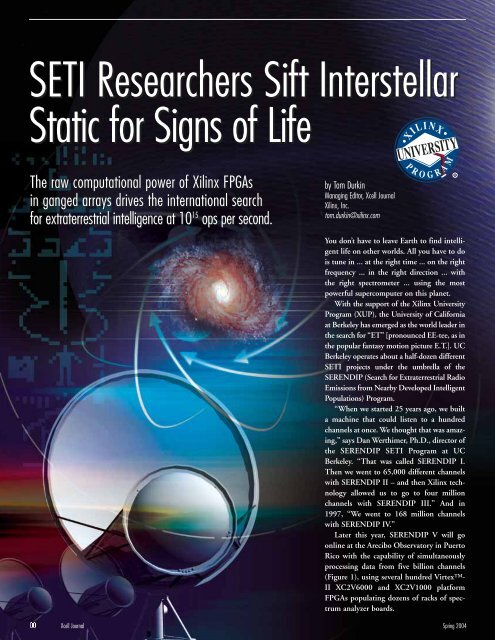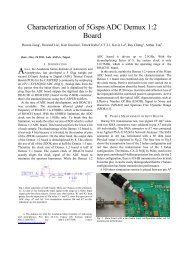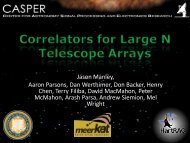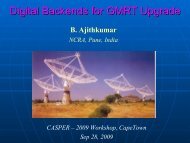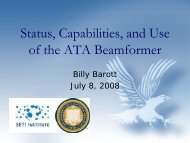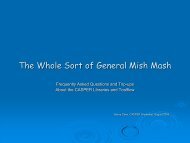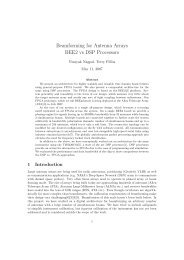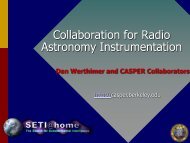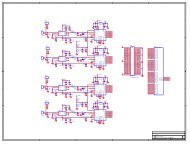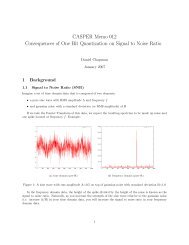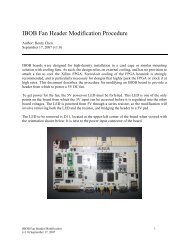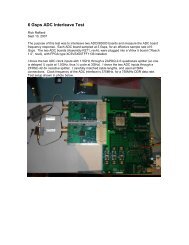SETI Researchers Sift Interstellar Static for Signs of Life SETI ...
SETI Researchers Sift Interstellar Static for Signs of Life SETI ...
SETI Researchers Sift Interstellar Static for Signs of Life SETI ...
You also want an ePaper? Increase the reach of your titles
YUMPU automatically turns print PDFs into web optimized ePapers that Google loves.
<strong>SETI</strong> <strong>Researchers</strong> <strong>Sift</strong> <strong>Interstellar</strong><br />
<strong>Static</strong> <strong>for</strong> <strong>Signs</strong> <strong>of</strong> <strong>Life</strong><br />
The raw computational power <strong>of</strong> Xilinx FPGAs<br />
in ganged arrays drives the international search<br />
<strong>for</strong> extraterrestrial intelligence at 1015 The raw computational power <strong>of</strong> Xilinx FPGAs<br />
in ganged arrays drives the international search<br />
<strong>for</strong> extraterrestrial intelligence at 10 ops per second.<br />
15 ops per second.<br />
by Tom Durkin<br />
Managing Editor, Xcell Journal<br />
Xilinx, Inc.<br />
tom.durkin@xilinx.com<br />
You don’t have to leave Earth to find intelligent<br />
life on other worlds. All you have to do<br />
is tune in ... at the right time ... on the right<br />
frequency ... in the right direction ... with<br />
the right spectrometer ... using the most<br />
powerful supercomputer on this planet.<br />
With the support <strong>of</strong> the Xilinx University<br />
Program (XUP), the University <strong>of</strong> Cali<strong>for</strong>nia<br />
at Berkeley has emerged as the world leader in<br />
the search <strong>for</strong> “ET” [pronounced EE-tee, as in<br />
the popular fantasy motion picture E.T.]. UC<br />
Berkeley operates about a half-dozen different<br />
<strong>SETI</strong> projects under the umbrella <strong>of</strong> the<br />
SERENDIP (Search <strong>for</strong> Extraterrestrial Radio<br />
Emissions from Nearby Developed Intelligent<br />
Populations) Program.<br />
“When we started 25 years ago, we built<br />
a machine that could listen to a hundred<br />
channels at once. We thought that was amazing,”<br />
says Dan Werthimer, Ph.D., director <strong>of</strong><br />
the SERENDIP <strong>SETI</strong> Program at UC<br />
Berkeley. “That was called SERENDIP I.<br />
Then we went to 65,000 different channels<br />
with SERENDIP II – and then Xilinx technology<br />
allowed us to go to four million<br />
channels with SERENDIP III.” And in<br />
1997, “We went to 168 million channels<br />
with SERENDIP IV.”<br />
Later this year, SERENDIP V will go<br />
online at the Arecibo Observatory in Puerto<br />
Rico with the capability <strong>of</strong> simultaneously<br />
processing data from five billion channels<br />
(Figure 1), using several hundred Virtex-<br />
II XC2V6000 and XC2V1000 plat<strong>for</strong>m<br />
FPGAs populating dozens <strong>of</strong> racks <strong>of</strong> spectrum<br />
analyzer boards.<br />
00 Xcell Journal Spring 2004
Number <strong>of</strong> Channels<br />
10 10<br />
10 9<br />
10 8<br />
10 7<br />
10 6<br />
10 5<br />
10 4<br />
10 3<br />
10 2<br />
10 1<br />
SERENDIP I<br />
100 Channels<br />
Hat Creek<br />
SERENDIP II<br />
65,536 Channels<br />
Arecibo<br />
SERENDIP Progress<br />
1979 1985 1991 1997 2003 2009<br />
Year<br />
With such an awesome capability to collect<br />
massive amounts <strong>of</strong> data, the<br />
SERENDIP scientists need far more computing<br />
power than they could possibly have<br />
with the high-end Sun Microsystems<br />
workstations at the Berkeley Space Sciences<br />
Laboratory. That’s where you and I come<br />
in. The <strong>SETI</strong>@home project is the largest<br />
supercomputer on the planet.<br />
Meanwhile, in the next few years, UC<br />
Berkeley’s Radio Astronomy Laboratory<br />
and the <strong>SETI</strong> Institute <strong>of</strong> Mountain View,<br />
Calif., will build the Allen Telescope Array,<br />
a bold innovation in radio telescope design<br />
– and a powerful new tool <strong>for</strong> <strong>SETI</strong><br />
research. As with the SERENDIP radio telescopes,<br />
Xilinx will provide the core technology<br />
to enable real-time digital signal<br />
processing at the unprecedented speed <strong>of</strong><br />
10 15 ops per second.<br />
And what happens if we do find ET?<br />
Virtually all <strong>of</strong> the world’s scientific community<br />
<strong>of</strong> <strong>SETI</strong> researchers have endorsed<br />
a United Nations treaty that requires the<br />
free and open disclosure <strong>of</strong> everything discovered<br />
and deciphered. How the rest <strong>of</strong><br />
humanity will react is anybody’s guess. A<br />
lot <strong>of</strong> it depends, says Werthimer, on<br />
whether the ET signal is accidental or<br />
intentional.<br />
SERENDIP III<br />
4,194,304<br />
Arecibo<br />
SERENDIP IV<br />
167,772,160<br />
Arecibo<br />
Figure 1 – SERENDIP DSP growth follows Moore’s Law<br />
SERENDIP V<br />
5,637,144,576<br />
Arecibo<br />
Tuning In to ET<br />
Radio waves (including television, radar,<br />
cell phones, and other microwave telecommunications)<br />
are considered the optimum<br />
band <strong>of</strong> the electromagnetic spectrum <strong>for</strong><br />
interstellar communication. Radio wavelengths<br />
are relatively free <strong>of</strong> the absorption<br />
and noise that afflict<br />
other areas <strong>of</strong> the spectrum.<br />
Additionally, stars<br />
are generally quiet in the<br />
radio wavelengths. This<br />
makes radio frequencies<br />
a natural candidate <strong>for</strong><br />
intentional interstellar<br />
communications – or<br />
“leakage” <strong>of</strong> local transmissions.<br />
Just as the “local transmissions”<br />
<strong>of</strong> American<br />
television shows, such as<br />
“I Love Lucy” and “The<br />
Honeymooners,” leaked<br />
out into space 50 years<br />
ago (and now have passed<br />
thousands <strong>of</strong> star systems),<br />
it is conceivable<br />
that we could intercept<br />
some extraterrestrial situation<br />
comedy show.<br />
Figure 2 – Arecibo Observatory, Puerto Rico<br />
Anatomy <strong>of</strong> Arecibo<br />
Operated by Cornell University and the<br />
National Science Foundation, the National<br />
Astronomy and Ionosphere Center Arecibo<br />
Observatory is the largest radio telescope<br />
on this planet (Figure 2).<br />
The spherical reflector dish measures<br />
1,000 feet (305 meters) across and covers<br />
20 acres. In what is considered a valid scientific<br />
calculation, Werthimer says the dish<br />
could theoretically hold 10 billion bowls <strong>of</strong><br />
cornflakes. Milk, however, would quickly<br />
drain out the almost 40,000 per<strong>for</strong>ated aluminum<br />
panels that make up the dish.<br />
Suspended 450 feet (137 meters) above<br />
the dish is a 900-ton (816 metric tons)<br />
plat<strong>for</strong>m that can be placed with millimeter<br />
precision anywhere up to twenty<br />
degrees from the vertical. A “Gregorian<br />
dome” on the plat<strong>for</strong>m contains two subreflectors<br />
(secondary and tertiary) to further<br />
focus deep space radio emissions.<br />
The plat<strong>for</strong>m also houses ultra-sensitive<br />
radio receivers cooled with liquid helium<br />
(to reduce electron noise) so the infinitesimally<br />
weak signals from outer space can be<br />
picked up amidst all the interstellar static<br />
and radio interference generated on Earth,<br />
orbiting satellites, and probes launched<br />
from Earth.<br />
Courtesy <strong>of</strong> the NAIC – Arecibo Observatory, a facility <strong>of</strong> the NSF<br />
Spring 2004 Xcell Journal 00
“… the name <strong>of</strong> the game in <strong>SETI</strong> is to search through as many<br />
frequencies as possible.” – Aaron Parsons, SERENDIP V design engineer<br />
Piggyback <strong>SETI</strong><br />
While most radio astronomers are lucky to<br />
get a day or two a year to use the Arecibo<br />
Observatory, “We figured out how to use the<br />
telescope 24 hours a day all year round by<br />
having our own feed antenna,” Werthimer<br />
says with a certain amount <strong>of</strong> glee.<br />
“The problem with that is that we<br />
don’t get to point the telescope, but<br />
that’s okay, because we don’t know<br />
where to look anyway,” he grins.<br />
“We call it piggyback <strong>SETI</strong>.”<br />
Spectacular Spectrometers<br />
Although radio telescope antennas<br />
are visually impressive and quite<br />
essential, they are useless without<br />
the instruments that receive and<br />
process the signals. The real guts <strong>of</strong><br />
radio telescopes are spectrometers,<br />
or spectrum analyzers, such as<br />
SERENDIP IV.<br />
SERENDIP IV<br />
The SERENDIP IV spectrometer at<br />
Arecibo consists <strong>of</strong> 120 Xilinx FPGAs on 40<br />
spectrum analyzer boards working in parallel<br />
to scan 168 million narrow-band (0.6 Hz)<br />
channels every 1.7 seconds.<br />
Each SERENDIP IV board computes a<br />
four million point Fast Fourier Trans<strong>for</strong>m<br />
(FFT). This four million point FFT is broken<br />
down into three smaller FFTs (128,<br />
128, and 256 points each). Xilinx chips<br />
comb the resulting power spectra <strong>for</strong> strong<br />
narrow-band signals and report their findings<br />
to the back-end computers at Berkeley<br />
<strong>for</strong> subsequent analysis, Werthimer says.<br />
SERENDIP V<br />
“We don’t know what frequency ET will<br />
be transmitting at, so the name <strong>of</strong> the game<br />
in <strong>SETI</strong> is to search through as many frequencies<br />
as possible,” explains Aaron<br />
Parsons, an engineer at the Berkeley Space<br />
Sciences Laboratory. Parsons is designing<br />
SERENDIP V, the next-generation spectrometer<br />
that will be able to process five<br />
IF Input<br />
From reciever<br />
Polarization 1<br />
(100 MHz Band)<br />
Polarization 2<br />
(100 MHz Band)<br />
billion channels simultaneously.<br />
As <strong>of</strong> press time, SERENDIP V was still<br />
on the drawing board, but it is on schedule<br />
to be installed at Arecibo later this year.<br />
The whole spectrometer will consist <strong>of</strong><br />
40 spectrum analyzer boards, each per-<br />
Gain<br />
Gain<br />
Test signal<br />
Test signal<br />
sin<br />
cos LPF ADC<br />
sin<br />
cos<br />
LPF ADC<br />
LPF ADC<br />
LPF ADC<br />
4K Channel<br />
Polyphase<br />
Filter<br />
Bank<br />
Virtex-II<br />
1/4 XC2V6000<br />
<strong>for</strong>ming a pair <strong>of</strong> 64 million point FFTs to<br />
handle a real-time signal bandwidth <strong>of</strong> 100<br />
MHz, Parsons says. Because Xilinx plat<strong>for</strong>m<br />
FPGAs have the capability <strong>of</strong> interfacing<br />
with double data rate DRAM<br />
memory chips, <strong>SETI</strong> engineers will be able<br />
to fit this 64 million point FFT onto a single<br />
Virtex-II XC2V6000 FPGA.<br />
Spectrum Splitting<br />
“We did this by first cutting the spectrum<br />
into coarse frequency bins using the characteristic<br />
frequency response <strong>of</strong> a 4,096channel<br />
polyphase filter bank,” Parsons<br />
explains (Figure 3). “The output data were<br />
then re-ordered using 256 MB <strong>of</strong> DRAM<br />
and broken into 16,384 smaller bins using<br />
a dual flow-through FFT we developed. It<br />
uses one-fourth <strong>of</strong> the space <strong>of</strong> a traditional<br />
FFT, he says with pride.<br />
Finally, in<strong>for</strong>mation about the best signals<br />
will be passed to a CPU over a compact<br />
PCI backplane using a Virtex-II<br />
XC2V1000 running a Xilinx PCI core,<br />
according to Parsons.<br />
Xilinx Chief DSP Architect Chris<br />
Dick, Ph.D., consulted on the design <strong>of</strong><br />
SERENDIP V. “The signal processing<br />
requirements in the <strong>SETI</strong> program pres-<br />
ent significant computational and I/O<br />
challenges that can only be met using<br />
Xilinx FPGAs,” Dick asserts. “Traditional<br />
processor-based approaches just cannot<br />
deliver the per<strong>for</strong>mance required <strong>for</strong> this<br />
challenging application.<br />
“The highly parallel compute fabric<br />
and I/O capability <strong>of</strong> the FPGA, however,<br />
is well suited to supporting the computational<br />
requirements <strong>of</strong> the filter<br />
banks and FFTs used in the polyphase<br />
trans<strong>for</strong>m channelizer,” Dick says.<br />
Key aspects <strong>of</strong> SERENDIP V were<br />
realized using a recent generation design<br />
flow from Xilinx called System Generator<br />
<strong>for</strong> DSP. This visual programming development<br />
environment is based on The<br />
MathWorks Simulink ® interactive tool<br />
<strong>for</strong> modeling, simulating, and analyzing<br />
dynamic, multidomain systems. It provides<br />
a natural framework <strong>for</strong> rapidly<br />
specifying and verifying complex signal<br />
processing systems, according to Dick.<br />
00 Xcell Journal Spring 2004<br />
4K Channel<br />
Polyphase<br />
Filter<br />
Bank<br />
Virtex-II<br />
1/4 XC2V6000<br />
4K x 16K<br />
Corner<br />
Turner<br />
4K x 16K<br />
Corner<br />
Turner<br />
16K Point<br />
FFT<br />
Virtex-II<br />
1/4 XC2V6000<br />
16K Point<br />
FFT<br />
Virtex-II<br />
1/4 XC2V6000<br />
Downconverter Board Spectrum Analyzer Board<br />
Figure 3 – SERENDIP V polyphase filter banks<br />
Post<br />
Processor<br />
Virtex-II<br />
XC2V1000<br />
Host<br />
CPU
Figure 4 – <strong>SETI</strong>@home “screen saver” data analysis program<br />
<strong>SETI</strong>@home Wants You<br />
As fast and as efficient as “ganged” (parallel)<br />
FPGAs are, the real-time data processed<br />
by SERENDIP IV still needs much further<br />
analysis. After the DSP (digital signal processing)<br />
algorithms in SERENDIP IV<br />
break down the incoming signal into 168<br />
million channels, some <strong>of</strong> the outgoing<br />
data is recorded onto high-density digital<br />
linear tape – about one 35 GB tape per day.<br />
The tapes are shipped to the Berkeley<br />
Space Sciences Laboratory. Even with highend<br />
Sun workstations, the amount <strong>of</strong> data<br />
far exceeds the lab’s ability to crunch the<br />
data. Thus, the <strong>SETI</strong>@home project was<br />
born. The SERENDIP scientists decided<br />
to farm out the massive computing task to<br />
idle computers all over the Internet (distributed<br />
grid computing), so they created<br />
<strong>SETI</strong>@home “screen saver” s<strong>of</strong>tware.<br />
Calling the <strong>SETI</strong>@home data analyzer<br />
s<strong>of</strong>tware a screen saver is a misnomer. The<br />
only resemblance the data analyzer has to<br />
real screen savers is that it only works when<br />
your computer is idle – and the graphical<br />
display <strong>of</strong> the data analysis in action is<br />
semi-hypnotic (Figure 6).<br />
If you want to join the hunt <strong>for</strong><br />
ET, you can download the<br />
<strong>SETI</strong>@home data analysis s<strong>of</strong>tware<br />
<strong>for</strong> free at http://setiathome.berkeley.edu.<br />
There are versions <strong>for</strong><br />
Windows, Macintosh, Unix, BeOS,<br />
OS/2, OpenVMS, and other operating<br />
systems.<br />
Once you’ve got it loaded, the<br />
<strong>SETI</strong>@home server at Berkeley sends you<br />
0.34 MB “work unit.” This is a very small<br />
chunk <strong>of</strong> data from the Arecibo tapes. The<br />
<strong>SETI</strong>@home data analyzer<br />
per<strong>for</strong>ms anywhere from<br />
between 2.4 trillion and 3.8<br />
trillion floating point calculations<br />
– including FFTs,<br />
de-chirping, and baseline<br />
smoothing, among others.<br />
Once the data is<br />
processed, the <strong>SETI</strong>@home<br />
program notifies you that it<br />
wants to report its results<br />
back to Berkeley and acquire<br />
another work unit. The only<br />
time the <strong>SETI</strong>@home data<br />
analyzer needs to be online is when data is<br />
being transferred.<br />
“When we get the data back from the<br />
participants, we comb through the strong<br />
signals looking <strong>for</strong> ET,” Werthimer says.<br />
Super Computing<br />
The <strong>SETI</strong>@home project is an awesome<br />
display <strong>of</strong> the power <strong>of</strong> distributed grid<br />
computing. Starting with a volunteer base<br />
<strong>of</strong> 1,500 volunteers in 1998,<br />
<strong>SETI</strong>@home has grown to more than 4.7<br />
million participants in 226 countries,<br />
with 2,000 new volunteers signing up<br />
daily, Werthimer reports.<br />
“The <strong>SETI</strong>@home volunteers have<br />
<strong>for</strong>med the planet’s largest supercomputer,<br />
averaging 60 teraflops [60 trillion floating<br />
point operations per second] and donating<br />
about 1,200 years <strong>of</strong> CPU time daily,” he<br />
says. “The search <strong>for</strong> ET is truly an international<br />
ef<strong>for</strong>t.”<br />
Allen Telescope Array<br />
While the <strong>SETI</strong> research will continue at<br />
Arecibo, the <strong>SETI</strong> Institute and the Radio<br />
Astronomy Laboratory at UC Berkeley<br />
have begun to build the Allen Telescope<br />
Array at the Hat Creek Observatory near<br />
Mt. Lassen in Northern Cali<strong>for</strong>nia. (The<br />
Radio Astronomy Laboratory and the<br />
SERENDIP Program are both departments<br />
within the Berkeley Space Sciences<br />
Laboratory).<br />
Underwritten by a large donation from<br />
Paul Allen, co-founder <strong>of</strong> Micros<strong>of</strong>t, the<br />
Allen Telescope Array will eventually grow<br />
to be a huge, expandable antenna farm<br />
(Figure 7) <strong>of</strong> as many as 350 20-foot (6.1meter)<br />
<strong>of</strong>fset Gregorian dishes with 8-foot<br />
(2.4-meter) secondary antennas. This<br />
innovative telescope design will cost much<br />
less than an equivalent single dish telescope,<br />
and it is expected to eclipse the<br />
Courtesy <strong>of</strong> the <strong>SETI</strong> Institute<br />
Figure 5 – Artist’s conception <strong>of</strong> Allen Telescope Array<br />
with <strong>of</strong>fset Gregorian dish antennas<br />
Spring 2004 Xcell Journal 00
magnification power <strong>of</strong> the Arecibo observatory<br />
by several orders <strong>of</strong> magnitude,<br />
according to Werthimer.<br />
Employing the same piggyback strategy<br />
used at Arecibo, <strong>SETI</strong> researchers will scan<br />
<strong>for</strong> ET wherever other radio astronomy<br />
research projects aim the array.<br />
Although these dishes can be “stamped<br />
out like hot tubs” very cheaply, Werthimer<br />
says, no one has ever attempted to build a<br />
giant telescope from so many small dishes<br />
be<strong>for</strong>e. The costs <strong>of</strong> the electronics and signal<br />
processing technology required to<br />
manage such an array were prohibitively<br />
high. The signal processing computation<br />
grows as the square <strong>of</strong> the number <strong>of</strong><br />
antennas, he explains. But, “Thanks to<br />
Virtex-II Pro and Spartan-3 chips,<br />
the peta-op per second signal processing<br />
costs will comprise only a tiny fraction <strong>of</strong><br />
the total system costs.”<br />
Each telescope (Figure 8) will have an<br />
extremely wide-band dual polarization feed,<br />
covering 0.5 GHz to 11.2 GHz. This feed<br />
will drive a pair <strong>of</strong> wide-band, low-noise<br />
amplifiers that output their signals to a pair<br />
<strong>of</strong> analog optical fiber laser modulators. All<br />
telescope fibers will be routed to the central<br />
electronic lab where the <strong>SETI</strong> signal processors<br />
and image processors will be located.<br />
To make maps <strong>of</strong> the radio sky, the<br />
FPGA-based “imager” <strong>for</strong> the antenna array<br />
must process real-time data at the rate <strong>of</strong> one<br />
terabit per second (10 12 bits/sec) and compute<br />
one peta-op per second (10 15 ops/sec) —<br />
that’s 20 times faster than the <strong>SETI</strong>@home<br />
supercomputer, Werthimer declares.<br />
First, each telescope signal will be digitized<br />
and broken up into 1,024 spectral<br />
components by means <strong>of</strong> a polyphase filter<br />
bank. The resulting data from each telescope<br />
will then be sent to a “corner turner” that<br />
will re-order this data by frequency channel.<br />
Next, each telescope “pair” will be<br />
cross-correlated and integrated (there are<br />
N*(N-1)/2 “pairs” <strong>of</strong> telescope signals to<br />
correlate). Then the data will be “2D<br />
Fourier trans<strong>for</strong>med” to produce an image.<br />
All signal processing and data routing will<br />
be implemented using several thousand<br />
Virtex II-Pro plat<strong>for</strong>m FPGAs in Rack 2<br />
and Spartan-3 FPGAs in Rack 4,<br />
Werthimer says.<br />
Rack 1<br />
Downconversion, sampling<br />
delay/phase tracking<br />
0.5 – 11.2 GHz<br />
analog fiber<br />
LO1 ADC<br />
350<br />
0.5 – 11.2 GHz<br />
analog fiber<br />
Basic ATA<br />
LO2<br />
LO3<br />
LO4<br />
Rack 2<br />
Time — frequency and<br />
truncation<br />
Turning Science Fiction into Fact<br />
<strong>SETI</strong> scientists operate on the assumption<br />
that there are other intelligent civilizations<br />
“out there.” Otherwise, why look? So, the<br />
question is not “if,” but “how many?” And<br />
where? And when will we find them?<br />
Xilinx University Program<br />
Xilinx donations to <strong>SETI</strong> research date<br />
back to 1988. Patrick Lysaght, senior director<br />
<strong>of</strong> Xilinx Research Labs, which includes<br />
the Xilinx University Program (XUP),<br />
reports that within the past five years,<br />
Xilinx has donated more than $1.5 million<br />
in hardware, s<strong>of</strong>tware, and technical support<br />
to UC Berkeley’s <strong>SETI</strong> research.<br />
“The search <strong>for</strong> extra terrestrial intelligence<br />
is a tremendously exciting adventure at<br />
the frontiers <strong>of</strong> science,” Lysaght says. “Xilinx<br />
FPGAs are uniquely suited to the huge computing<br />
demands <strong>of</strong> projects such as <strong>SETI</strong>.”<br />
Werthimer is unrestrained in his gratitude<br />
to XUP: “The Xilinx University<br />
Program has really made this whole thing<br />
possible. Not only did you guys develop<br />
the core technology that we needed to<br />
process 168 million channels simultaneously,<br />
but you have this generous program<br />
that gives us the s<strong>of</strong>tware and the chips to<br />
build SERENDIP V.”<br />
Werthimer’s gratitude goes beyond<br />
words. In a memo to XUP last year, he<br />
wrote: “We’d like to reciprocate as best we<br />
can <strong>for</strong> all the wonderful stuff you’ve<br />
donated.” For example: “We have a flowthrough<br />
dual FFT and polyphase filter<br />
design that Xilinx and its customers are<br />
welcome to use. It uses one-fourth <strong>of</strong> the<br />
memory that the Xilinx FFT IP core uses,<br />
and it calculates two complex FFTs<br />
simultaneously at 240 million samples<br />
per second.”<br />
00 Xcell Journal Spring 2004<br />
350<br />
Channel Selector<br />
Channel Selector<br />
350 12.8 Gbit/s data paths<br />
Polyphase<br />
Filter Bank<br />
(FPGA)<br />
PFB<br />
PFB<br />
PFB<br />
PFB<br />
PFB<br />
PFB<br />
PFB<br />
PFB<br />
PFB<br />
70<br />
Parallel to serial converter Parallel to serial converter (FPGA)<br />
70 8 Gbit/s data paths<br />
Rack 3<br />
Switching<br />
Packet switch<br />
(Commerciallyproduced<br />
or<br />
Corner turner<br />
600 Gbit/s aggragate<br />
bandwidth<br />
This proposal<br />
Figure 6 – Proposed Allen Telescope Array image <strong>for</strong>mer<br />
64 8.75 Gbit/s data paths<br />
Cross multiply<br />
X<br />
Rack 4<br />
Correlation<br />
FPGA<br />
64<br />
FPGA<br />
Integrate<br />
To other experiments<br />
(pulsar praocessor<br />
beam <strong>for</strong>mers, etc.)<br />
”N“ CPUs<br />
“The Xilinx University Program has really made<br />
this whole thing possible.”<br />
– Dan Werthimer, director, SERENDIP <strong>SETI</strong> Program
Contact<br />
Why are companies like Xilinx, Sun<br />
Microsystems, Intel, Toshiba,<br />
Hewlett Packard, Quantum,<br />
Network Appliance, Fujifilm – as<br />
well as non-pr<strong>of</strong>it organizations like the<br />
<strong>SETI</strong> Institute, the <strong>SETI</strong> League, and<br />
The Planetary Society – contributing<br />
millions <strong>of</strong> dollars worth <strong>of</strong> technology<br />
and expertise to support the search <strong>for</strong><br />
ET? Xilinx CEO Wim Roelandts puts it<br />
this way: “You can say, well, maybe it is<br />
science fiction, but to prove it isn’t, you<br />
need state-<strong>of</strong>-the-art technology. This is<br />
probably the ultimate science problem we<br />
must solve. The intellectual challenge is<br />
enormous. And that is what is exciting.”<br />
Within the <strong>SETI</strong> community, the<br />
word “excited” has become almost a code<br />
word <strong>for</strong> the discovery <strong>of</strong> ET. Pretty<br />
much everybody uses the word “excited”<br />
when they describe how they’ll feel when<br />
a signal from ET is scientifically confirmed.<br />
That means replicated results<br />
from other, independent observatories,<br />
such as those in Australia, Italy, France,<br />
and Argentina.<br />
“We actually want to look at the sky<br />
many, many times,” Werthimer explains.<br />
“One <strong>of</strong> our most robust algorithms is:<br />
Did you see the signal again, in same<br />
place, when the telescope comes back to<br />
the same place in the sky? Do we see it in<br />
the same place at the same frequency? –<br />
that’s what gets us really excited.”<br />
Un<strong>for</strong>tunately, in the last 44 years <strong>of</strong><br />
serious, scientific research, nobody’s<br />
found anything to get all that excited<br />
about.<br />
“I’m optimistic,” Werthimer says. “I<br />
think we might find ET in our lifetimes,<br />
but I think, right now, we’d be very lucky<br />
to find ET. So, I’m sort <strong>of</strong> counting on<br />
Moore’s Law. If Moore’s Law keeps<br />
going, and if Xilinx keeps on making<br />
faster and better chips, the better the<br />
chances we have <strong>of</strong> finding an extraterrestrial<br />
radio signal.”<br />
Two Scenarios<br />
“There are sort <strong>of</strong> two scenarios <strong>for</strong> contact<br />
with ET,” Werthimer reasons. “One<br />
is that we find a signal, and we aren’t<br />
really able to decode it. It could just be a<br />
navigational beacon – there’s no in<strong>for</strong>mation.<br />
All we would know is that they’re<br />
out there.<br />
“The more scary scenario to me,”<br />
Werthimer continues, “is that we might<br />
receive a direct broadcast with a huge<br />
amount <strong>of</strong> in<strong>for</strong>mation content in the<br />
ET signal – and that could be used in<br />
good ways or bad ways.”<br />
To prevent the potential abuse <strong>of</strong><br />
extraterrestrial intelligence, virtually all<br />
<strong>SETI</strong> research organizations – including<br />
the <strong>SETI</strong> SERENDIP Program, the<br />
<strong>SETI</strong> Institute, the <strong>SETI</strong> League, and<br />
The Planetary Society, to name just a few<br />
– have endorsed Article XI <strong>of</strong> the United<br />
Nations Treaty on Principles Governing<br />
the Activities <strong>of</strong> States in the Exploration<br />
and Use <strong>of</strong> Outer Space. In part, Article<br />
XI decrees that the discoverers <strong>of</strong> ET<br />
must “... in<strong>for</strong>m the Secretary General <strong>of</strong><br />
the United Nations, as well as the public<br />
and the international scientific community,<br />
to the greatest extent feasible and<br />
practicable, <strong>of</strong> the nature, conduct, locations,<br />
and results ...” <strong>of</strong> the discovery.<br />
Furthermore, the treaty calls <strong>for</strong> a<br />
transnational decision on whether to<br />
reply to ET – and if so, what to say.<br />
Conclusion<br />
We may discover ET any time from now<br />
to never. It’s pretty much impossible to<br />
predict exactly how humanity will react,<br />
but it’s reasonably certain that many if<br />
not most <strong>of</strong> the world’s religious communities<br />
would be pr<strong>of</strong>oundly disrupted.<br />
If we receive “leakage”-type signals –<br />
navigational beacon or cosmic comedy<br />
show – Werthimer says, “I don’t think<br />
that’s really going to totally shake up the<br />
planet very much. A lot <strong>of</strong> people already<br />
think there are ETs out there and the<br />
universe is teeming with life.”<br />
If on the other hand, we receive a content-rich,<br />
intentional broadcast from<br />
another civilization attempting to contact<br />
us, perhaps the best advice we can<br />
take is from Douglas Adams’ satirical science<br />
fiction novel The Hitchhiker’s Guide<br />
to the Galaxy: “Don’t panic and always<br />
carry a clean towel.”<br />
Hyperlinks to <strong>SETI</strong> Research<br />
Allen Telescope Array:<br />
www.seti.org/science/ata.html<br />
Arecibo Observatory:<br />
www.naic.edu/bigtable.htm<br />
Drake Equation:<br />
www.seti-inst.edu/seti/seti_science/<br />
drake_equation.html<br />
Origins: Astrobiology:<br />
The Search <strong>for</strong> <strong>Life</strong>:<br />
www.exploratorium.edu/origins/arecibo/<br />
<strong>SETI</strong>@home:<br />
setiathome.ssl.berkeley.edu<br />
<strong>SETI</strong> at the University <strong>of</strong><br />
Cali<strong>for</strong>nia, Berkeley:<br />
seti.berkeley.edu<br />
<strong>SETI</strong> Institute:<br />
www.seti.org<br />
<strong>SETI</strong> League:<br />
www.setileague.org<br />
The Planetary Society:<br />
seti.planetary.org<br />
Xilinx University Program:<br />
www.xilinx.com/univ/<br />
Protocols <strong>for</strong> Contact<br />
Treaty on Principles Governing the<br />
Activities <strong>of</strong> States in the Exploration<br />
and Use <strong>of</strong> Outer Space:<br />
www.oosa.unvienna.org/SpaceLaw/<br />
outersptxt.htm<br />
<strong>SETI</strong> Institute:<br />
www.seti.org/science/principles.html<br />
<strong>SETI</strong> League:<br />
www.setileague.org/general/protocol.htm<br />
The Planetary Society:<br />
seti.planetary.org/Contact/<br />
AfterTheDetection.html<br />
Spring 2004 Xcell Journal 00


